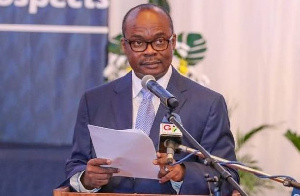 BoG Governor, Ernest Addison
BoG Governor, Ernest Addison
Data released last week by the Bank of Ghana on the lending rates demanded by commercial banks in Ghana reveal that the most banks are still demanding unusually high-interest rate spreads between their cost of funds and the rates at which they are willing to give loans to their customers.
However, the new data covers the first quarter of 2021 and therefore does not take into account lending rate reductions implemented following the central bank’s 100 basis points cut in its benchmark Monetary Policy Rate, announced at the end of March.
That rate cut was followed by a 40 basis point cut in the Ghana Reference Rate, which is computed as the base lending rate for all the banks with each bank adding on an interest spread for each specific loan it gives, based on the perceived risk inherent in that particular loan.
The GRR currently stands at 13.51 percent, effective since August 4 and this is virtually the same as the MPR which has been retained at 13.50 percent over the past five months.
The new data reveals that 17 of the 23 commercial banks currently operating in Ghana demand average lending rates that give them at least five percent interest spreads over the average base lending rate for the entire industry.
These include Consolidated Bank, 21.62 percent; FBN Bank 22.25 percent; Fidelity, 20.64 percent; First Atlantic 21.23 percent; First National Bank, 20.55 percent; GCB Bank 22.80 percent; National Investment Bank, 21.77 percent; Prudential, 21.93 percent; Republic Bank, 21.03 percent; Stanbic, 20.86 percent; Standard Chartered; 20.82 percent; United Bank for Africa, 20.05 percent; Universal Merchant Bank, 20.39 percent; and Zenith Bank, 19.45 percent.
The three banks with the highest average lending rates demand spreads of over 10 percent above the GRR. These are Absa Bank, 23.59 percent; Societe Generale and 23.61 percent and ADB, 24.89 percent.
On the other hand, the lowest average effective lending rates are offered by: CAL Bank – 15.97 percent; Access Bank – 17.77 percent; Bank of Africa 17.19 percent; Ecobank Ghana – 18.41 percent; Guaranty Trust Bank – 16.97 percent; and Omni/BSIC Bank – 17.95 percent.
Importantly all the effective lending rates revealed by the BoG include the effect of fixed fees related to loans – such as loan management fees – which are duly annualized and added to the respective coupon rates.
However, these averages can be deceptive as some banks apply extraordinarily wide ranges between the lowest and highest effective rates with the latter significantly higher than the highest charged by other banks who have relatively lower average lending rates.
Besides, banks which are willing to provide relatively high risk credit – most notably to SMEs in contrast to multinationals, and to agriculture in contrast to commerce – have to charge relatively high lending rates to compensate for the inevitably higher loan default rates they are forced to cope with.
Here, ADB is a clear example, lending about half of its loan book to an agricultural sector that most other banks are barely willing to expose themselves to because of the inordinate accompanying credit risk; it is instructive that ADB’s non-performing loans ratio at close to 30 percent is inevitably twice the 14.89 percent industry average as at the end of 2020.
Indeed many banking industry analysts contend that the level of risk a bank is generally ready to take on in its loan book reflects in the average interest rates it charges; the higher the average lending rate the more the risk a bank is ready to take on.